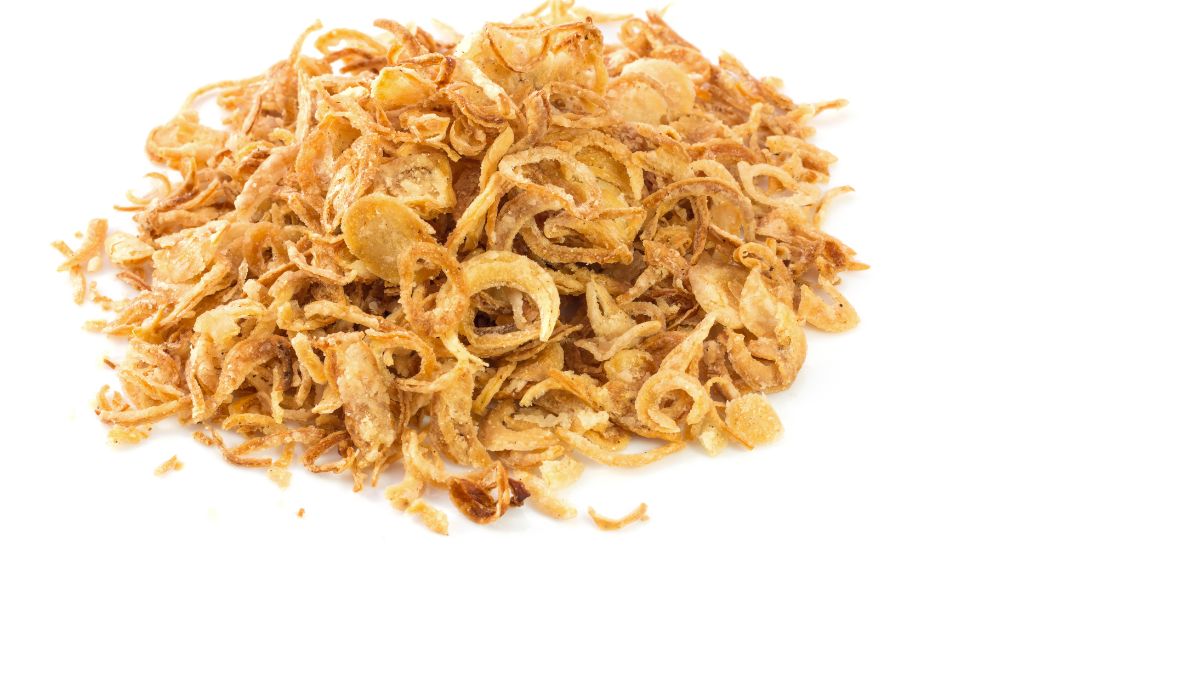This post contains affiliate links. See the affiliate disclaimer here.
Are you a fan of that irresistible crunch and savory flavor that French fried onions bring to your favorite dishes? Whether you sprinkle them on top of casseroles, salads, or burgers, these crispy little delights add a burst of deliciousness to any meal.
But what happens when you find a forgotten bag of French fried onions in the back of your pantry? Do they go bad? In this article, we’ll explore the shelf life of French fried onions and answer the burning question: do French fried onions go bad?
Key Takeaways
- French fried onions have a long shelf life and can be stored for months without losing their quality or taste.
- Proper storage is key to maintaining the shelf life of French fried onions. Keep them in a cool, dry place away from direct sunlight or heat sources and seal the container tightly after each use.
- The shelf life of French fried onions can vary depending on the brand and packaging, so always check the expiration or best-by date on the packaging.
- Signs of French fried onions going bad include a change in appearance, off odor, mold growth, and an off taste. If you notice any of these signs, it’s best to discard the onions.
- Proper storage of French fried onions involves checking the packaging for specific instructions, using airtight containers, storing in a cool and dry place away from sunlight, keeping away from strong odors, and avoiding freezing.
- By following these storage guidelines, you can extend the shelf life of French fried onions and maintain their quality and flavor.
What are French fried onions?
French fried onions are a popular and versatile ingredient that can liven up a wide range of dishes with their unique crunch and savory flavor. These crispy little delights are made by deep-frying thin slices or rings of onions until they turn golden brown and crispy.
The process of making French fried onions involves coating the onion slices with flour, eggs, and seasonings before being fried in hot oil. This combination creates a deliciously crispy texture with a rich and savory taste that complements a variety of dishes.
French fried onions are commonly used as a topping for green bean casserole, adding a delightful crunch to the creamy dish. However, their uses extend far beyond this classic dish. You can sprinkle them over salads, soups, burgers, and even tacos to add a burst of flavor and texture.
Due to their long shelf life and ability to enhance a multitude of dishes, French fried onions have become a staple in many households. They are convenient and can be easily stored in the pantry for months without losing their quality or taste.
Whether you use them as a topping or as an ingredient in a recipe, French fried onions bring a delightful crunch and savory flavor that can elevate your dishes to the next level. So, the next time you’re at the supermarket, be sure to grab a bag of these crispy onion delights and unlock a world of culinary possibilities.
Shelf life of French fried onions
When it comes to the shelf life of French fried onions, you’ll be glad to know that they have a surprisingly long-lasting nature. These crispy and flavorful onions can be stored in your pantry for months without losing their quality or taste.
The key to maintaining the shelf life of French fried onions lies in proper storage. Make sure to keep them in a cool, dry place away from direct sunlight or heat sources. This will help prevent moisture and humidity from affecting their texture and taste.
It’s also important to seal the container tightly after each use. This helps to keep air and moisture out, preserving the crispness of the onions. If stored correctly, French fried onions can easily last for up to 6 months.
It’s worth noting that the shelf life can vary depending on the brand and the specific packaging. Some brands may have a shorter or longer shelf life, so it’s always a good idea to check the expiration or best-by date on the packaging. If stored properly, the onions should remain safe to eat even after the expiration date, but their quality may gradually decline over time.
So, don’t worry about your French fried onions going bad anytime soon. With the right storage conditions, you can enjoy their delightful crunch and savory flavor for months on end, adding a delicious touch to your favorite dishes. Keep some on hand to liven up your green bean casserole, sprinkle over salads, soups, burgers, or tacos, and enjoy the flavor and convenience that French fried onions bring to your kitchen.
Signs that French fried onions have gone bad
When it comes to French fried onions, it’s important to be able to identify if they have gone bad. While these crispy and flavorful toppings have a long shelf life when stored properly, there are signs that indicate they may no longer be safe to eat. Here are the tell-tale signs that your French fried onions have gone bad:
- Change in Appearance: One of the first signs that French fried onions have gone bad is a change in their color and texture. Fresh French fried onions are golden brown and crispy. If they start to turn darker or become mushy, it’s a clear indicator that they are past their prime.
- Off Odor: Another warning sign that your French fried onions have gone bad is a strong, unpleasant odor. Fresh French fried onions have a distinct savory smell. However, if you notice a rancid or foul odor coming from the container, it’s a sign that they have spoiled.
- Mold Growth: Mold is a common sign of spoilage in many food products, and French fried onions are no exception. If you spot any patches of mold or fungal growth on the onions, it’s best to discard them immediately. Consumption of moldy food can lead to health problems.
- Off Taste: The taste of French fried onions should be crispy, savory, and slightly sweet. If the taste is off, bitter, or unpleasant, it’s a strong indication that they have gone bad. Trust your taste buds and avoid consuming French fried onions that don’t taste right.
When it comes to enjoying French fried onions, freshness is key. If you observe any of these signs, it’s crucial to discard the onions to avoid any potential health risks. Remember, always check the expiration or best-by date, and make sure to store them properly in a cool, dry place away from direct sunlight or heat sources.
Proper storage of French fried onions
To ensure the quality and flavor of your French fried onions, proper storage is crucial. Here are some essential tips to effectively store your French fried onions:
1. Check the packaging: Before storing your French fried onions, make sure to check the packaging for any specific instructions or guidelines. Some brands might provide recommendations for optimal storage conditions.
2. Use airtight containers: Transfer the French fried onions into airtight containers to protect them from moisture, air, and potential contaminants. Airtight containers help to maintain the crispness and freshness of the onions for a longer period.
3. Store in a cool and dry place: Find a cool and dry spot in your pantry or kitchen cabinets to store the French fried onions. Exposing them to excessive heat or humidity can lead to the onions losing their crunchiness and becoming stale.
4. Keep away from direct sunlight: Sunlight can speed up the degradation process and cause the French fried onions to become rancid. Ensure that the storage area is away from direct sunlight or any intense sources of light.
5. Avoid storing near strong odors: French fried onions are susceptible to absorbing strong odors from the surroundings. Keep them away from pungent foods or spices that may affect the aroma and taste of the onions.
6. Do not freeze: While freezing is a common storage method for many foods, it is not recommended for French fried onions. Freezing can change the texture and taste of the onions, resulting in a less than desirable experience when used in recipes.
By following these storage guidelines, you can extend the shelf life of your French fried onions and maintain their quality and flavor. Always remember to check for any signs of spoilage such as changes in appearance, off odors, mold growth, or an off taste. If you notice any of these signs, it’s crucial to discard the onions to prevent any potential health risks.
Conclusion
Proper storage is key to maintaining the quality and flavor of French fried onions. By following a few simple guidelines, you can extend their shelf life and enjoy them for longer.
Firstly, always check the packaging for any specific storage instructions. This will give you valuable information on how to best preserve the onions.
Next, transfer the onions into airtight containers. This will protect them from moisture and contaminants, ensuring that they stay fresh and crispy.
Remember to store the onions in a cool, dry place away from direct sunlight and strong odors. These factors can negatively impact their taste and texture.
Lastly, avoid freezing French fried onions. Freezing can alter their texture and taste, leading to a less enjoyable eating experience.
By following these storage guidelines, you can prevent potential health risks and enjoy the full flavor of your French fried onions for longer. So, go ahead and stock up on this versatile and delicious ingredient, knowing that you can store them properly and enjoy them whenever you want.
Frequently Asked Questions
Q: What are some tips for storing French fried onions?
A: To store French fried onions, check the packaging for specific instructions. Transfer them into airtight containers to protect from moisture and contaminants. Store in a cool, dry place away from sunlight and strong odors.
Q: Can French fried onions be frozen?
A: No, freezing French fried onions is not recommended as it can alter their texture and taste. It is best to store them in a cool, dry place.
Q: How long can French fried onions be stored?
A: The shelf life of French fried onions varies depending on the packaging and storage conditions. However, if stored properly, they can last for several months, maintaining their quality and freshness.
Q: Are there any health risks associated with storing French fried onions?
A: Storing French fried onions improperly can potentially lead to health risks. Moisture, contaminants, and exposure to sunlight or strong odors can cause spoilage and promote bacterial growth. It is important to follow proper storage guidelines to prevent any health risks.

